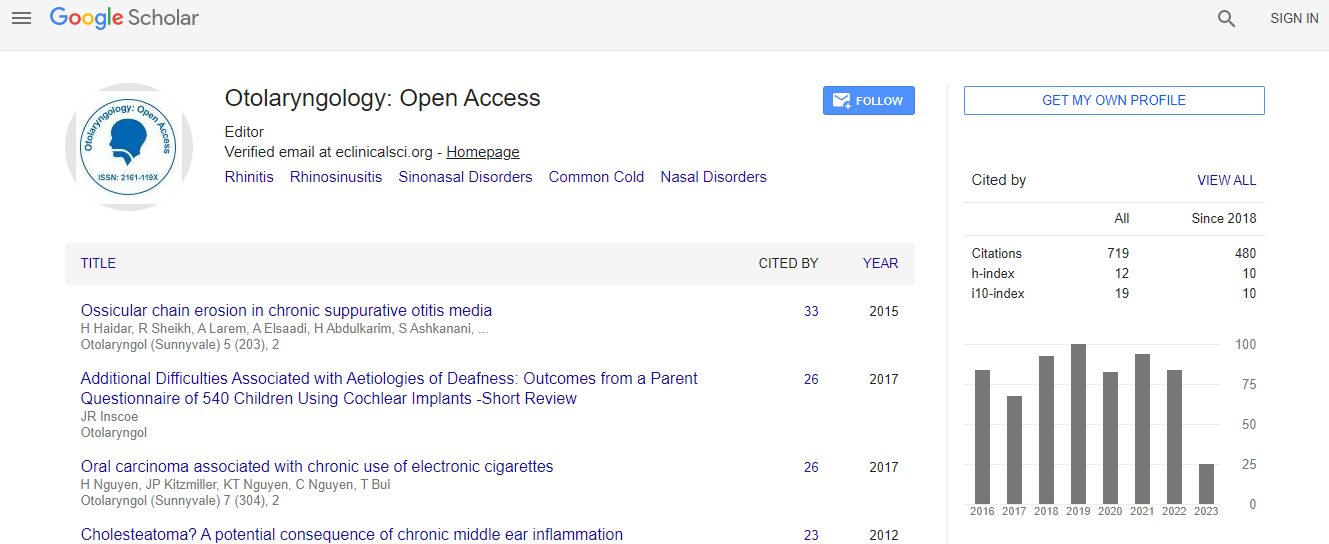Our Group organises 3000+ Global Conferenceseries Events every year across USA, Europe & Asia with support from 1000 more scientific Societies and Publishes 700+ Open Access Journals which contains over 50000 eminent personalities, reputed scientists as editorial board members.
Open Access Journals gaining more Readers and Citations
700 Journals and 15,000,000 Readers Each Journal is getting 25,000+ Readers
Google Scholar citation report
Citations : 925
Otolaryngology: Open Access received 925 citations as per Google Scholar report
Otolaryngology: Open Access peer review process verified at publons
Indexed In
- Index Copernicus
- Google Scholar
- Sherpa Romeo
- Open J Gate
- Genamics JournalSeek
- RefSeek
- Hamdard University
- EBSCO A-Z
- OCLC- WorldCat
- Publons
- Geneva Foundation for Medical Education and Research
- ICMJE
Useful Links
Recommended Journals
Related Subjects
Share This Page
Auricular schwannoma: A case report
Joint Event on 4th European Otolaryngology-ENT Surgery Conference & 3rd International Conference on Craniofacial Surgery
Raid M. AL-Ani and Haidar Khudair Abd
University of Anbar, College of Medicine, Iraq
ScientificTracks Abstracts: Otolaryngol (Sunnyvale)
Abstract
Schwannoma is a benign tumour of schwann cells and is seldom to be seen in the auricle. In the literature, very few cases of schwannomas originating in the pinna were reported. In this article, we described a 35-year-old female patient who presented with right painless auricular mass which was treated by excision under general anesthesia. The clinical and histopathologic features, the differential diagnosis, and the treatment of auricular schwannoma are discussed.Key words: auricle, schwannoma, Iraq.
Introduction: Schwannomas are slowly growing benign tumour of neuro-ectodermal origin. Schwannomas are well known to arise from schwann cell of the branches of peripheral, cranial or autonomic nerves. They are usually presented as a painless solitary swelling. They are affecting the head and neck in a 25-45%, where the vestibular schwannoma is the commonest. The presentation of head and neck schwannomas depends on their location. Auricle is a rare site of affection by schwannoma (1). The first case of external ear schwannoma was reported in 1977 (2). When we were reviewing the literatures, only five cases of auricular schwannomas were reported in the world (1-5). In the present article we describe a further case of auricular schwannoma.
Verocay in 1908 was the first who describe the solitary schwannoma and gave it the name of neurinoma; the name schwannoma was assigned by Batsakis in 1974. Schwannoma is also known by other terms, such as neurinoma, neurilemmoma, mioschwannoma, schwannoglioma, etc (6). The first case of auricular schwannoma was reported by Fodor et al in 1977. Following this case only 4 cases were reported in the world (1-5).
Schwannoma is a slowly growing, painless, benign, encapsulated tumour arising from schwann cell, so any nerves could be affected by this kind of tumour except the olfactory and optic nerves. Affection of the external ear by schwannoma is extremely rare (7).
The nerve supply to the auricle are derived from auriculotemporal, greater auricular, lesser occipital and partly from facial and vagus nerves (1). Owing to the location of the presenting case, the swelling may have originated from the branch of greater auricular nerve.
Due to its rarity occurrence, auricular shwannoma is rarely put in the differential diagnosis of the swelling of the pinna. The final diagnosis of the schwannoma depends on histopathological evaluation and immunohistochemical study. The treatment of choice for such tumour is by complete surgical excision. The recurrence is rare after complete surgical removal (7).
Conclusion: Despite auricular schwannoma is extremely rare tumour, it should be considered in the differential diagnosis of a benign looking swellings of the pinna.
Biography
Dr. Raid M. Al-Ani , I got MBChB from Kufa College of Medicine in 1989. He is working as a Otolaryngologist since 2000 when I achieved the Fellowship of Iraqi Board for Medical Specializations in Otolaryngology and Head and Neck Surgery. In 2015, he achieved the MRCS from Edinburgh. I got the fellowship of European board in Otolaryngology and Head and Neck Surgery in 2017. In addition to his practice as an Otolaryngologist and an instructor, he received many positions like a chief of department, Assistant Dean for Scientific affairs and Post graduate Studies and others.
E-mail: raedalani2003@yahoo.com

 Spanish
Spanish  Chinese
Chinese  Russian
Russian  German
German  French
French  Japanese
Japanese  Portuguese
Portuguese  Hindi
Hindi 
